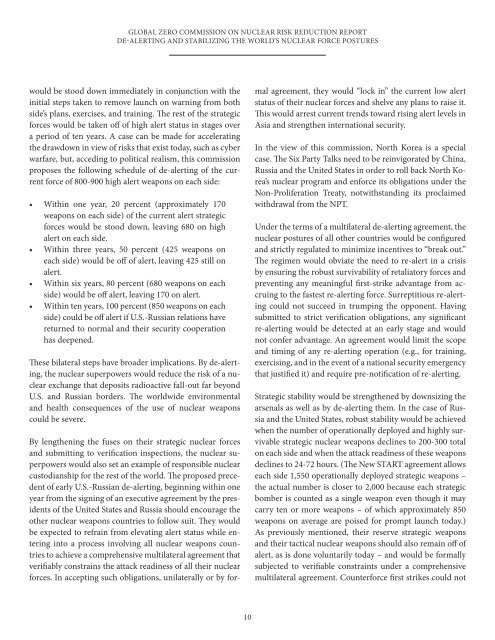global_zero_commission_on_nuclear_risk_reduction_report
global_zero_commission_on_nuclear_risk_reduction_report
global_zero_commission_on_nuclear_risk_reduction_report
You also want an ePaper? Increase the reach of your titles
YUMPU automatically turns print PDFs into web optimized ePapers that Google loves.
GLOBAL ZERO COMMISSION ON NUCLEAR RISK REDUCTION REPORTDE-ALERTING AND STABILIZING THE WORLD’S NUCLEAR FORCE POSTURESwould be stood down immediately in c<strong>on</strong>juncti<strong>on</strong> with theinitial steps taken to remove launch <strong>on</strong> warning from bothside’s plans, exercises, and training. The rest of the strategicforces would be taken off of high alert status in stages overa period of ten years. A case can be made for acceleratingthe drawdown in view of <strong>risk</strong>s that exist today, such as cyberwarfare, but, acceding to political realism, this <str<strong>on</strong>g>commissi<strong>on</strong></str<strong>on</strong>g>proposes the following schedule of de-alerting of the currentforce of 800-900 high alert weap<strong>on</strong>s <strong>on</strong> each side:• Within <strong>on</strong>e year, 20 percent (approximately 170weap<strong>on</strong>s <strong>on</strong> each side) of the current alert strategicforces would be stood down, leaving 680 <strong>on</strong> highalert <strong>on</strong> each side.• Within three years, 50 percent (425 weap<strong>on</strong>s <strong>on</strong>each side) would be off of alert, leaving 425 still <strong>on</strong>alert.• Within six years, 80 percent (680 weap<strong>on</strong>s <strong>on</strong> eachside) would be off alert, leaving 170 <strong>on</strong> alert.• Within ten years, 100 percent (850 weap<strong>on</strong>s <strong>on</strong> eachside) could be off alert if U.S.-Russian relati<strong>on</strong>s havereturned to normal and their security cooperati<strong>on</strong>has deepened.These bilateral steps have broader implicati<strong>on</strong>s. By de-alerting,the <strong>nuclear</strong> superpowers would reduce the <strong>risk</strong> of a <strong>nuclear</strong>exchange that deposits radioactive fall-out far bey<strong>on</strong>dU.S. and Russian borders. The worldwide envir<strong>on</strong>mentaland health c<strong>on</strong>sequences of the use of <strong>nuclear</strong> weap<strong>on</strong>scould be severe.By lengthening the fuses <strong>on</strong> their strategic <strong>nuclear</strong> forcesand submitting to verificati<strong>on</strong> inspecti<strong>on</strong>s, the <strong>nuclear</strong> superpowerswould also set an example of resp<strong>on</strong>sible <strong>nuclear</strong>custodianship for the rest of the world. The proposed precedentof early U.S.-Russian de-alerting, beginning within <strong>on</strong>eyear from the signing of an executive agreement by the presidentsof the United States and Russia should encourage theother <strong>nuclear</strong> weap<strong>on</strong>s countries to follow suit. They wouldbe expected to refrain from elevating alert status while enteringinto a process involving all <strong>nuclear</strong> weap<strong>on</strong>s countriesto achieve a comprehensive multilateral agreement thatverifiably c<strong>on</strong>strains the attack readiness of all their <strong>nuclear</strong>forces. In accepting such obligati<strong>on</strong>s, unilaterally or by formalagreement, they would “lock in” the current low alertstatus of their <strong>nuclear</strong> forces and shelve any plans to raise it.This would arrest current trends toward rising alert levels inAsia and strengthen internati<strong>on</strong>al security.In the view of this <str<strong>on</strong>g>commissi<strong>on</strong></str<strong>on</strong>g>, North Korea is a specialcase. The Six Party Talks need to be reinvigorated by China,Russia and the United States in order to roll back North Korea’s<strong>nuclear</strong> program and enforce its obligati<strong>on</strong>s under theN<strong>on</strong>-Proliferati<strong>on</strong> Treaty, notwithstanding its proclaimedwithdrawal from the NPT.Under the terms of a multilateral de-alerting agreement, the<strong>nuclear</strong> postures of all other countries would be c<strong>on</strong>figuredand strictly regulated to minimize incentives to “break out.”The regimen would obviate the need to re-alert in a crisisby ensuring the robust survivability of retaliatory forces andpreventing any meaningful first-strike advantage from accruingto the fastest re-alerting force. Surreptitious re-alertingcould not succeed in trumping the opp<strong>on</strong>ent. Havingsubmitted to strict verificati<strong>on</strong> obligati<strong>on</strong>s, any significantre-alerting would be detected at an early stage and wouldnot c<strong>on</strong>fer advantage. An agreement would limit the scopeand timing of any re-alerting operati<strong>on</strong> (e.g., for training,exercising, and in the event of a nati<strong>on</strong>al security emergencythat justified it) and require pre-notificati<strong>on</strong> of re-alerting.Strategic stability would be strengthened by downsizing thearsenals as well as by de-alerting them. In the case of Russiaand the United States, robust stability would be achievedwhen the number of operati<strong>on</strong>ally deployed and highly survivablestrategic <strong>nuclear</strong> weap<strong>on</strong>s declines to 200-300 total<strong>on</strong> each side and when the attack readiness of these weap<strong>on</strong>sdeclines to 24-72 hours. (The New START agreement allowseach side 1,550 operati<strong>on</strong>ally deployed strategic weap<strong>on</strong>s –the actual number is closer to 2,000 because each strategicbomber is counted as a single weap<strong>on</strong> even though it maycarry ten or more weap<strong>on</strong>s – of which approximately 850weap<strong>on</strong>s <strong>on</strong> average are poised for prompt launch today.)As previously menti<strong>on</strong>ed, their reserve strategic weap<strong>on</strong>sand their tactical <strong>nuclear</strong> weap<strong>on</strong>s should also remain off ofalert, as is d<strong>on</strong>e voluntarily today – and would be formallysubjected to verifiable c<strong>on</strong>straints under a comprehensivemultilateral agreement. Counterforce first strikes could not10


